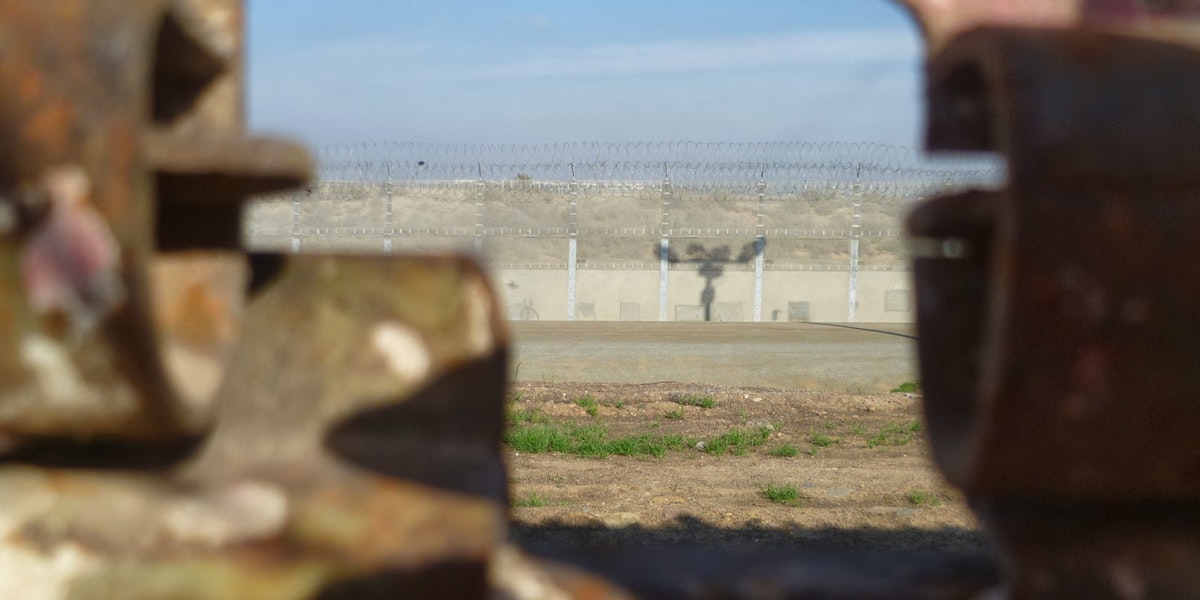Ever since July 11, when the Sinaloan drug baron Joaquin “El Chapo” Guzman engineered a brazen escape from the most secure prison in Mexico, the story of his flight from justice has played, at least in the United States, as entertainment. An initial round of media reports detailed the extraordinary particulars of his escape—a mile long tunnel leading directly from his cell to a hastily constructed building on farmland outside the prison walls, a motorcycle that had been specially modified to run on rails and transport Guzman through the tunnel to safety. The story then took a surreal turn, when a Twitter account that ostensibly belonged to Guzman began issuing threats to Donald Trump. The idea that this salvo might have genuinely come from the kingpin was laughable from the beginning: while Guzman’s sons appear to have an active presence on social media, he has always made a fetish of secure communications, and he is believed to be scarcely literate; even if you stipulated that the Twitter account bearing his name was real, the idea that mere hours after escaping from a maximum security prison he would take time out to pick a fight with an American presidential candidate is ludicrous even by the standards of the drug war. (Needless to say, none of this stopped Trump from treating the threat as though it was genuine, announcing that he feared for his safety and had consulted the FBI, and milking the publicity down to the last drop.)
Guzman’s gradual transformation from wanted murderer to late-night punchline may have found its apotheosis this month, in a new wave of stories about how, with Halloween approaching, a “Chapo” costume—shovel and prison stripes optional—is flying off the shelves.
This callous insouciance on the part of the American public about the drug war should not be surprising: over the past decade, as the death toll escalated in Mexico, Americans have remained curiously indifferent both to the human carnage and to the threat of anarchy in our neighbor to the south. This myopia remained possible primarily because, even during the worst years of the presidency of Felipe Calderon, most of the bloodshed was confined to Mexico. Some U.S. observers raised the specter of so-called “spillover violence,” but apart from the occasional isolated incident, it never came. Even as Juarez became the most dangerous city in the world, with a higher murder rate per capita in 2010 than wartime Afghanistan or Iraq, El Paso—right over the border in Texas—remained one of the safest cities in the United States.
There is a temptation, when we talk about barbaric violence, to assume that it is irrational, but even the homicidal foot-soldiers of Guzman’s Sinaloa cartel, and of their rivals, Los Zetas, knew that while they might be able to kill with impunity in Mexico, it would be a mistake to try the same thing in the United States. The cartels are extremely active in the United States, and not just along the border: they move drugs into and around the country and they launder their money in American banks. But they do not kill here in the way that they do in Mexico. This discretion on the part of the cartels has, for the moment, at least, enabled both the public and the political establishment in the United States to behave as though the crisis of the drug war, to the degree that there is one, is Mexico’s crisis—and not ours.
Takes Two to Tango
The idea that America is not complicit in Mexico’s drug economy is nonsense, of course: it is untrue as a matter of obvious fact, but it is also a self-serving and unethical stance to take, given the extent to which the United States is implicated in the activity of the cartels. Guzman had already escaped from a Mexican prison once before, when he snuck out of a maximum security facility called Puente Grande in 2001. He managed to remain at large for thirteen years, battling other cartels and consolidating his territorial gains, until he became, in the estimation of the U.S. Treasury Department, “the world’s most powerful drug trafficker.” When he escaped a second time, many American commentators expressed astonishment and dismay over the degree to which the cartels have corrupted the political system in Mexico—as if that corruption were somehow an indigenously Mexican phenomenon. But it is America’s rampant demand for narcotics (in combination with our quixotic commitment to prohibit them) that has underwritten the rise of Guzman and other cartel leaders. The vast resources that cartels wield are drawn from the steady contributions of weekend drug users and hardcore addicts in the United States. The cartels reap billions of dollars every year in drug revenue, and much of that cash is laundered through the U.S. financial system, often with the help of major international banks. (Wachovia and HSBC have both been implicated by authorities in helping the cartels launder hundreds of millions of dollars.)
So while we tend to think of the drug trade in the Americas as a single arrow, pointing north, representing the product that flows through Mexico into the United States, we should instead acknowledge a second vector—the equal and opposite flow of American money moving south across the border and into the coffers of the cartels.
And if Americans, through their drug consumption, underwrite the power of the cartels to corrupt the Mexican political establishment, we also underwrite the lethality of these organizations—with our guns. The majority of the weapons deployed by the sicarios of the cartels are firearms purchased in the United States—where the gun laws are, by the standards of Mexico or nearly any other nation on the planet, appallingly lax—and smuggled south across the border.
In the narrow optic of American security debates, however, the threat to the nation seems always to take the form of something malignant, like drugs, coming into the country, rather than something like money or guns flowing out. This blinkered conception is on vivid display at any official point of entry on the southwest border, where northbound traffic is slowed to a crawl and subjected to questions and searches, and southbound traffic is much more casually waved through.
Who Actually Governs Mexico?
Of course, America’s moral culpability in the travails of foreign countries, even close neighbors, has not tended, historically, to be a reliable trope for spurring political action. But there are more immediately self-interested and strategic reasons for a reevaluation in the way we think about the drug trade and security in Mexico in the wake of Guzman’s escape.
It is destabilizing for the United States in a number of subtle but crucial respects to be in a situation in which the government of our neighbor to the south—which is also our third-largest trading partner—cannot be said to exercise meaningful sovereign control over its own territory. When Guzman escaped from prison in 2001, he did so with extensive official complicity. Seventy-one members of the prison staff were subsequently jailed for assisting him—including the warden. Throughout the presidency of George W. Bush, Guzman was the most-wanted drug lord in Mexico and a major law enforcement priority for Washington, a man whose cartel would eventually become responsible for as much as 40 percent of all the illegal narcotics that crossed the border from Mexico to the U.S. each year. After the killing of Osama bin Laden in 2011, Guzman became perhaps the most wanted fugitive on the planet, with a $5 million U.S. bounty on his head. Yet, he continued to operate with a relatively free hand in Mexico. Authorities knew, roughly, where he was, but because he spent hundreds of millions of dollars on bribes each year, it was effectively impossible to capture him, because any time Mexican authorities moved against the kingpin, somebody would tip him off in advance. Even a timely assault was not a sure thing, as Guzman was surrounded by an army of gunmen, who possessed enough local knowledge and powerful weaponry that they could hold off Mexico’s armed forces. U.S. law enforcement does not have jurisdiction to make arrests in foreign countries—a sensitivity that is especially pronounced in Mexico, where the issue of sovereignty has been exacerbated over the past two centuries by a shifting border and a number of U.S. invasions.
In Washington, this has led to deep frustration. During the presidency of Felipe Calderon, U.S. authorities worked very closely with their Mexican counterparts, and the resulting frontal assault on the cartels led to a severe escalation in bloodshed, with very few strategic gains to show for it: the flow of drugs across the border did not diminish, and while some cartels fractured, others simply took over their territory, becoming more powerful in the process. When Enrique Pena Nieto came into office in 2012, he indicated that he would break with Calderon’s approach to the cartels, focusing more on reducing violence, and holding the overbearing security forces of the United States at arm’s length, reasserting greater sovereign independence from the gringos. Yet, to the surprise of many observers, his administration was able, with assistance from the United States, to kill or capture one cartel leader after another.
This successful campaign to “decapitate” the cartels with targeted operations against their leaders culminated in the extraordinary capture of Guzman in the resort town of Mazatlan, on Mexico’s Pacific coast, in February 2014. For the U.S. Drug Enforcement Administration (DEA) and other law enforcement agencies, the solution to Mexico’s pervasive corruption had come in the form of a series of small vetted units from Mexico’s marines. Whereas the army, the municipal police, and other elements of the military and law enforcement apparatus in Mexico were perceived, by Washington, as hopelessly penetrated by the cartels, corruption was less entrenched in the marines. Even so, the members of the unit that ultimately captured Guzman were not informed of where they were going and who their target was until they boarded the helicopters to launch the operation. (As a precaution, all cell phones were confiscated before they were told.) These kinds of precautions may have seemed onerous, but they ended up yielding a situation in which Guzman was finally located and captured before he was tipped off and had an opportunity to flee.
In the United States, the success of the operation was greeted with triumphalism and relief, but in Mexico, the reaction was more complicated. According to polls, a majority of Mexican respondents believed that Guzman was more powerful than the government in Mexico City. Many observers had so little confidence in the integrity and capability of their government that they assumed some sort of deception must be in play: Guzman could not possibly have been taken against his will; perhaps he turned himself in, or somehow engineered his own capture, tired of his years on the run; he would retire, now, to the luxury wing of some prison, built to his specifications, just as Pablo Escobar had once constructed a comfortable facility for his own form of house arrest in Colombia. Perhaps Guzman wouldn’t retire at all—when he was imprisoned the first time, he continued to operate his drug empire from behind bars, so what would stop him from doing the same now? Another common theory in Mexico was that it was not Guzman who the marines had captured at all: it was a body double, a clever ploy by the wily trafficker to throw U.S. agents off his scent. Yes, the government had subjected the captured man to a DNA test that confirmed his identity as Guzman, but the government had always done Guzman’s bidding; how hard would it be to fake the test? In Guzman’s home state of Sinaloa, many citizens reacted not with disbelief but indignation. In this poor, largely agrarian, chronically underserved corner of western Mexico, people had so little faith in their government (and such vivid memories of Guzman’s occasional acts of local charity) that they regarded the drug lord as a Robin Hood figure, a hometown success story. They demanded his release from prison and protested, by the hundreds, in the streets.
The Revolving Door of the Mexican Justice System
The rule of law problem in Mexico is endemic not just on the operational frontlines of the military and law enforcement, but in the judicial establishment as well. As a result, officials from the Department of Justice in Washington have often pushed their counterparts in Mexico City, aggressively, to extradite captured criminal suspects to the United States for trial. As with the boots-on-the-ground issue involving American investigators operating inside Mexico, this matter is fraught with concerns over sovereignty. In years past, Mexico has at times proved very willing to turn over suspects to the United States, where they often face federal indictments for drug trafficking. But at other times, Mexican officials have objected, for understandable reasons, that violent criminals who stood accused not only of exporting drugs to the United States, but also of the more serious crime of unleashing violent mayhem inside Mexico must first face justice domestically for their crimes. Officials in Mexico also have objected to a tendency on the part of U.S. prosecutors to cut deals: on numerous occasions in recent decades, the United States. would prevail upon Mexico to turn over a notorious trafficker, only to “flip” the trafficker once he was on U.S. soil, enlisting him to inform on and testify against his former colleagues, then giving him, in recompense, a minimal sentence—and eventually, letting him go. (Of course, U.S. officials often point out, the distaste that Mexican officials feel for this arrangement may be driven as much by a fear of the tales of high-level corruption that a flipped cartel leader might share with U.S. authorities as by any broader commitment to justice.)
The problem, from a U.S. perspective, with allowing prized suspects to remain in Mexico is that however good the intentions of the senior officials who pushed to hold onto them, Mexico has simply not had the capacity to reliably try, convict, and jail the most powerful criminals. One of the most notorious Mexican drug traffickers, a friend of Guzman’s named Rafael Caro Quintero, was arrested in Costa Rica and extradited to Mexico in 1985, for his role in the kidnapping and murder of a U.S. DEA agent, Enrique (Kiki) Camarena. He was sentenced to forty years in a Mexican prison, with the understanding that, should he still be alive when he finished his sentence, he would be turned over to the United States to face additional charges. One night, in August 2013, Caro Quintero was quietly released from prison. He was set free on a technicality, but if you’re wondering whether Mexican authorities believed that judgment would withstand scrutiny, it is worth considering the hour of his release: 2:00 a.m. As soon as U.S. officials learned of Caro Quintero’s early exit, they furiously demanded that he be returned to custody and extradited to face trial here. But by that time, he had disappeared. He reportedly fled into the mountains, and it seems unlikely that he will ever be captured again.
Against this backdrop, the U.S. Department of Justice appealed to the Pena Nieto administration to turn over Guzman following his arrest. There was precedent here, they pointed out: Guzman had already escaped from the most secure facility in Mexico, in 2001. He faced half a dozen federal indictments in jurisdictions across the United States, and because of precisely the kinds of deals with cooperators that Mexican officials disdained, federal prosecutors in cities such as Chicago had witnesses who had done business directly with Guzman and who were ready to testify against him in court. The indictments carried multiple life sentences, U.S. officials argued, and Guzman would likely serve his time at the federal Supermax in Florence, Colorado—from which not a soul, to date, has escaped.
But Pena Nieto and his government bristled at the entitlement with which the U.S. assumed Guzman would simply be turned over, and at the explicit suggestion that Mexico was somehow not up to the job. If the saga of the drug war is in part a parable about the Mexican government’s insecurity over its own sovereign power vis-à-vis the United States, the Guzman case is a story about the Mexican government’s insecurity over its sovereign power vis-à-vis Guzman. Pena Nieto and his elite marines had surprised everybody by catching the trafficker whose whole legend was premised on the idea that he was too powerful to catch. As public relations, the arrest was a coup not just for Pena Nieto but for the whole notion of governance in Mexico. But just because you can catch Guzman, it does not necessarily follow that you can hold him. So when Washington suggested that the only responsible thing was to extradite him—in hindsight, an accurate assessment—the symbolic politics of the situation all but dictated that Mexico had to demur. Jesus Murillo Karam, Pena Nieto’s attorney general, joked confidently to the Associated Press that Mexico would be happy to turn Guzman over to the United States “in three hundred or four hundred years.”
It did not help this dynamic that Guzman’s capture coincided with an embarrassing spectacle in parts of western and southern Mexico in which citizen militia groups, known as autodefensas, took up arms to resist the dominion of the cartels. This form of popular vigilante activity represented an implicit (and often explicit) rebuke of Pena Nieto’s government, a suggestion that if the official powers that be are so corrupted, demoralized or outmatched that they cannot protect the people, then the people will be forced to take matters into their own hands. The capture of Guzman, and the suggestion that he might be held in isolation, tried in rigorous court proceedings, and made to answer for his barbaric crimes, might function as a well-timed symbolic riposte.
The Flight of El Chapo
We now know that Guzman had scarcely arrived in prison before plans were under way to break him out. His associates purchased property near the prison where he was being held and began to burrow underground a year prior to his escape. And since July, it has emerged that U.S. intelligence and law enforcement had indications, months in advance, that Guzman’s sons were looking to spring him from custody, and that this crucial warning was shared with the Pena Nieto administration.
With any other inmate, it might be reasonable to claim that escape via a mile-long tunnel was so audacious as to be entirely unpredictable. But long before his first stint in prison, Guzman was a famous proponent of tunnels. A quarter of a century ago, he hired architects and engineers to devise tunnels for transporting drugs across the border; it was an innovation that made him famous, and endowed him with a critical comparative advantage during his early years in the business. According to the U.S. Department of Homeland Security, the Sinaloa cartel has been linked to one hundred or so border tunnels in recent decades.
Since Guzman’s escape, the Mexican government has arrested prison guards and officials, as well as a pilot who allegedly flew the kingpin to safety. But nobody watching the sorry aftermath of this incident believes that all those who enabled the escape will be identified, much less brought to justice: the escape was so sophisticated, so brazen, and so long in the making that it could only have entailed the complicity of dozens, even hundreds of co-conspirators, with abettors extending into the highest echelons of the Mexican government.
Suddenly, the capture of El Chapo in 2014 seems not to herald a new chapter in the rule of law in Mexico. Instead, it appears, in retrospect, to have been an aberration. Trust between the United States and Mexico, which had improved dramatically, to a point where the DEA shared with its Mexican counterparts the intelligence that enabled authorities to track Guzman to Mazatlan and arrest him, has since frayed. Several weeks ago, Mexico extradited a handful of captured cartel members to the United States, which might seem like a promising development, insofar as Pena Nieto’s government appeared more ready, after Chapo’s escape, to concede that major traffickers were more likely to face justice on this side of the border. But at the same time, the admission of prosecutorial and judicial bankruptcy that this entails is dispiriting.
Mexican authorities are hunting for El Chapo once again, and earlier this month, the marines used helicopter gunships to shoot up a neighborhood where Guzman was believed to be hiding, in a remote corner of the Sierra Madre. According to Mexican officials, Guzman’s men opened fire with heavy weaponry on their pursuers, and the drug lord was injured, breaking his leg after he jumped off a cliff. The blunt tactics of the marines sent hundreds of local residents fleeing into the mountains for safety, yet somehow, El Chapo managed to escape once again.
What Can the United States Do Now?
As election season intensifies in the United States and immigration again becomes an issue, it is remarkable the degree to which the debate overlooks the connection between the flow of migrants seeking to cross into the United States and the political instability and criminal anarchy in the countries that they are fleeing. In recent decades, American presidents have argued that war and instability as far away as Kosovo or Afghanistan represents a sufficient threat to the broader global order and the narrow security interests of the United States that our country is duty-bound to intervene. Yet we remain curiously indifferent to the profound instability in some parts of Latin America—including Mexico—that is one of the most significant push factors driving migrants out of their countries and onto our doorstep. Small nations like El Salvador and Honduras have become overrun by corruption and criminal gangs. Because Mexico is larger in terms of its population, its economy, and its physical territory, it is better able to absorb a rampant criminal culture without betraying signs of societal collapse; if you visit Mexico City or Guadalajara or Monterrey, they still seem like vibrant, cosmopolitan metropolises, and cartel violence has declined considerably in recent years. But beneath the surface, the civic culture in Mexico is in serious jeopardy, and the inescapable suggestion left by the escape of Guzman is that, in the struggle for authority, the state looks like a loser, and the cartels will forever prevail.
What can the United States do about all this? We can start by paying attention, and acknowledging that while the carnage may stop just short of our border, we share some significant portion of the blame. In the near term, the only expedient solution on criminal justice issues is to continue to pressure Mexico to extradite high-value suspects for trial and prison in the United States. But in the medium term, we must focus on assisting Mexico in building more robust institutions of criminal justice, even if it means focusing our cooperative efforts and our resources on small, elite cadres such as the marines who captured Guzman. We will never wipe out corruption in Mexico—we’ll never do so in the United States, either—but we can work to contain it, and to reward those organs of the Mexican government that prove both competent and incorruptible. Training and resourcing prosecutors and judges will be important, as will devising systems to protect them and their families from harm—as the Italian government was forced to do with those who prosecute the mafia.
But in assessing the problem of corruption in Mexico, officials in the United States must also think holistically, and acknowledge the extent to which the corruption is underwritten by the steady flow of U.S. dollars from drug consumers in this country. It might be hubris to believe that we can impose a more transparent and accountable political culture on Mexico from the outside; that is beyond our remit, and our control. But what we can do is tend to our share of the dynamic, by stanching the flow of money to the cartels. For all of the vast resources that the United States devotes to drug interdiction, it does very little to curb (or even to analyze) the outflow of drug money. By focusing both on cash smuggled in bulk across the border, and on the complicity of major financial institutions in laundering money for the cartels, we might discover an indirect means of attacking the culture of corruption in Mexico—by starving it of funds.
In the long run, however, the most important and effective solution to the violence, instability, and corruption born of the drug trade will be to reconcile the fundamental paradox that gave rise to it: the United States is at once the biggest market for narcotics on the planet, and one of the chief international proponents of prohibition. While the gradual decriminalization of cannabis is a promising step in resolving this tension—one that may ultimately have a real impact on the bottom line of the cartels—it is unlikely that harder drugs, such as cocaine, heroin, and particularly methamphetamine, will be legalized or decriminalized any time soon. Even so, the tension between prohibition and consumption can still be diminished—through a greater focus on addiction and other factors that contribute to America’s immense appetite for drugs.
In 2009, in a rare moment of candor by a U.S. official on this issue, Hillary Clinton acknowledged that the drug trade is fueled by “our insatiable demand for illegal drugs.” And as it happens, treatment for drug addiction has proved to be the most cost-efficient means of reducing drug abuse in this country—a far better return on investment than all of the many expensive steps that we have taken to stop drugs at the border or to go after the cartels. Yet drug treatment programs are chronically underfunded, and generally represent an afterthought in presidential strategies to tackle this issue.
Supply-side solutions are important, and the U.S. should work with Mexico to capture and try the criminal leaders who threaten the sovereignty of our neighbor and ally and who undermine security and human rights throughout the region. But the only realistic long-term solution to this pressing security challenge lies in the painstaking and unglamorous but crucially important realm of demand.










